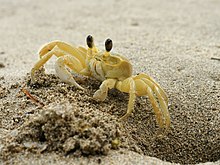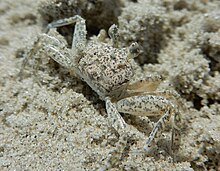The Atlantic ghost crab, Ocypode quadrata, is a species of ghost crab. It is a common species along the Atlantic coast of the United States, where it is the only species of ghost crab;[2] its range of distribution extends from its northernmost reach on beaches in Westport, Massachusetts, south along the coasts of the tropical Western Atlantic Ocean to the beach of Barra do Chui, in Rio Grande do Sul in southern Brazil.[3]
| Atlantic ghost crab | |
|---|---|

| |
| Adult O. quadrata by a burrow entrance | |

| |
| Juvenile O. quadrata | |
| Scientific classification | |
| Domain: | Eukaryota |
| Kingdom: | Animalia |
| Phylum: | Arthropoda |
| Class: | Malacostraca |
| Order: | Decapoda |
| Suborder: | Pleocyemata |
| Infraorder: | Brachyura |
| Family: | Ocypodidae |
| Genus: | Ocypode |
| Species: | O. quadrata
|
| Binomial name | |
| Ocypode quadrata | |
| Synonyms | |
| |
Description edit
Adults are greyish or the color of straw, and around 5 cm (2.0 in) wide at maturity.[4] They must return to water periodically to moisten their gills, and when larvae must be released into the sea, but are otherwise terrestrial.[4] Their stalked compound eyes can swivel to give them 360° vision.[2] Young crabs are cryptically colored to blend in with their sandy habitats.[2]
Distribution edit
Atlantic ghost crabs are found from Santa Catarina north to Massachusetts, USA. They have been recorded in Block Island, Rhode Island, Nantucket, Massachusetts, Martha's Vineyard, Massachusetts, Delaware beaches, northern Virginia beaches, the Outer Banks of North Carolina to Santa Catarina, Brazil, on Fernando de Noronha, and Bermuda. Its planktonic larvae have been documented in Woods Hole, Massachusetts, although the adults have not been recorded at this location. [4]
Fossil record edit
Fossil specimens of O. quadrata have been found in rocks dating from the Pleistocene.[5]
Ecology edit
The Atlantic ghost crab lives in burrows in sand above the strandline.[2] Older individuals dig their burrows farther from the sea, some starting as much as 400 m (1,300 ft) inland.[4] Burrows can be up to 1.3 m (4 ft 3 in) deep, and can be closed off with sand during hot periods.[4]
This crab can produce a variety of sounds by striking the ground with the claw, by stridulation with the legs, and an incompletely explained "bubbling sound".[6] Males compete in a heavily ritualised manner which prevents the need for physical contact.[6][further explanation needed]
Ghost crabs are arguably the fastest terrestrial invertebrates, capable of running at more than a meter per second.[7]
O. quadrata is more active at night than in the day, and is an omnivore,[2] eating clams (such as conquina clams and Donax spp.),[8] mole crabs (including Emerita talpoida),[9][8] insects, plant material, detritus, and even other crabs.[6] They also feed on the eggs and hatchlings of sea turtles, such as the loggerhead sea turtle.[9][8]
Sandy beaches, a habitat frequented by ghost crabs, have had a decrease in the abundance of ghost crabs due to human behavior.[10] Ghost crabs are negatively impacted by human and vehicle trampling, which results in direct crushing of crabs, as well as indirect damage such as compression of sediment which reduces habitat suitability, interference with reproductive behaviors, reduction in food supply, and light pollution.[11] Consequently, it is less common on beaches frequented by people.
Self-awareness edit
A 2023 study using the well known mirror test found that these crabs seem to be capable of recognizing themselves in a mirror. The study's author concluded that the data indicate that the crabs have "a rudimentary form of self-awareness".[12]
References edit
- ^ Sammy De Grave; N. Dean Pentcheff; Shane T. Ahyong; et al. (2009). "A classification of living and fossil genera of decapod crustaceans" (PDF). Raffles Bulletin of Zoology. Suppl. 21: 1–109. Archived from the original (PDF) on 2011-06-06. Retrieved 2010-01-02.
- ^ a b c d e Jeffrey S. Pippen (November 12, 2005). "Ghost crab (Ocypode quadrata)". Jeffrey S. Pippen. Archived from the original on November 2, 2013. Retrieved June 10, 2013.
- ^ Adilson Fransozo, Maria Lucia Negreiros-Fransozo & Giovana Bertini (2002). "Morphometric studies of the ghost crab Ocypode quadrata (Fabricius, 1787) (Decapoda: Ocypodidae) from Ubatuba, São Paulo, Brazil". In E. Escobar-Briones; F. Álvarez (eds.). Modern Approaches to the Study of Crustacea. New York: Kluwer/Plenum. pp. 189–195. ISBN 0-306-47366-6.
- ^ a b c d e David Knott. "Atlantic Ghost Crab, Ocypode quadrata" (PDF). South Carolina Department of Natural Resources. Archived from the original (PDF) on October 31, 2020. Retrieved January 2, 2009.
- ^ Roger W. Portell, Richard L. Turner & John L. Beerensson (2003). "Occurrence of the Atlantic ghost crab Ocypode quadrata from the Upper Pleistocene to Holocene Anastasia Formation of Florida". Journal of Crustacean Biology. 23 (3): 712–722. doi:10.1651/C-2340.
- ^ a b c Jeffrey Shields (1998). "The ghost crab, Ocypode quadrata". Virginia Institute of Marine Science. Archived from the original on January 4, 2010. Retrieved January 2, 2010.
- ^ • Whittemore, S. B., Hoglin, B., Green, M. A., & Medler, S. (2015). Stride frequency in relation to allometric growth in ghost crabs. Journal of Zoology, 296(4), 286–294. https://doi.org/10.1111/jzo.12244
- ^ a b c Izzo, Lisa; Kothari, Nikhita. "Ocypode quadrata (Atlantic ghost crab)". Animaldiversity.org. Retrieved 16 March 2022.
- ^ a b "Ocypode quadrata (Atlantic Ghost Crab)" (PDF). Sta.uwi.edu. Retrieved 16 March 2022.
- ^ Thomas A. Schlacher, Luke Thompson & Sam Price (2007). "Vehicle versus conservation of invertebrates on sandy beaches: mortalities inflicted by offroad vehicles on ghost crabs". Marine Ecology. 28 (3): 354–367. Bibcode:2007MarEc..28..354S. doi:10.1111/j.1439-0485.2007.00156.x.
- ^ Graziani de Freitas Antunes, Ana Paula Nunes do Amaral; Fabiana Pinto Ribarcki, Elenir de Fátima Wiilland; Denise Maria Zancan, Anapaula Sommer Vinagre (2010). "Seasonal variations in the biochemical composition and reproductive cycle of the ghost crab Ocypode quadrata (Fabricius, 1787) in Southern Brazil". Journal of Experimental Zoology. 313A (5): 280–291. Bibcode:2010JEZA..313..280A. doi:10.1002/jez.593. PMID 20127661.
- ^ Robinson, T. (14 June 2023). "Mirror self-recognition in ghost crab (Ocypode quadrata)". Animal Cognition. 26 (5): 1539–1549. doi:10.1007/s10071-023-01800-2. PMID 37314594. Retrieved 25 November 2023.
External links edit
- Media related to Ocypode quadrata at Wikimedia Commons